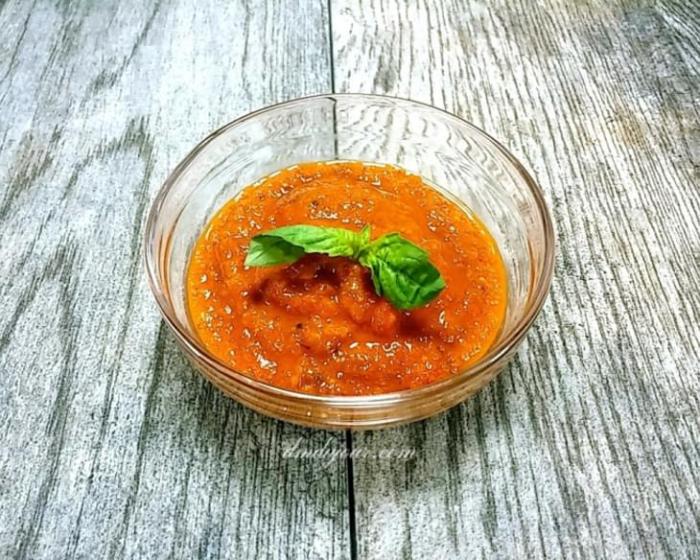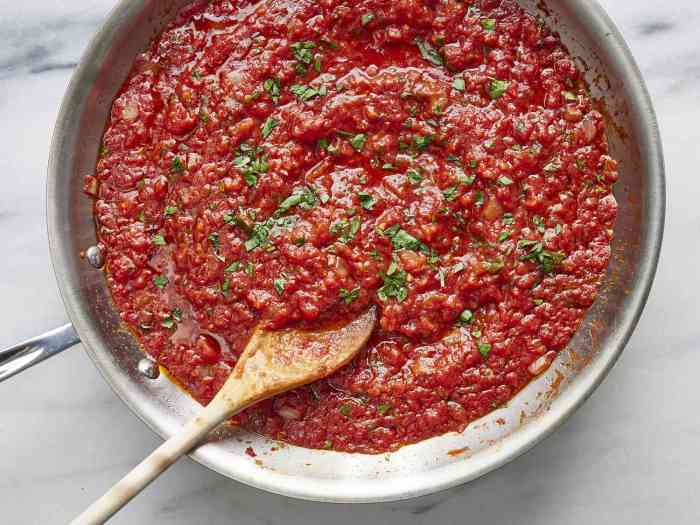Basil Marinara Sauce Recipe A Culinary Delight
Basil Marinara Sauce: A Culinary Journey
Basil marinara sauce recipe – Basil marinara sauce, a cornerstone of Italian-American cuisine, boasts a rich history intertwined with the cultural significance of simple, fresh ingredients. Its evolution reflects the fusion of culinary traditions, resulting in a sauce that is both versatile and deeply satisfying. This exploration delves into the creation of this classic sauce, from ingredient selection to flavor variations and serving suggestions.
Introduction to Basil Marinara Sauce
The history of basil marinara sauce is intrinsically linked to the history of tomato-based sauces in Italy. While the exact origins are debated, the combination of tomatoes, garlic, basil, and olive oil emerged as a staple in Neapolitan cuisine. The sauce’s cultural significance lies in its simplicity and ability to transform humble ingredients into a culinary masterpiece, reflecting the Italian emphasis on fresh, seasonal produce.
A good basil marinara sauce is characterized by its bright, vibrant flavor, a balanced sweetness and acidity, and a smooth, yet slightly textured consistency. Variations exist across regions, with some incorporating additional herbs, spices, or vegetables, reflecting local culinary traditions and preferences. For instance, a Sicilian marinara might include olives and capers, while a Roman version might focus on the interplay of tomatoes and garlic.
Ingredient Selection and Preparation
The quality of ingredients significantly impacts the final flavor of the basil marinara sauce. Using high-quality tomatoes, fresh basil, and good olive oil is crucial. Fresh basil leaves should be carefully washed, gently dried to avoid bruising, and finely chopped to release their aromatic oils. The type of tomato used significantly affects the sauce’s flavor profile, acidity, and texture.
| Tomato Type | Flavor Profile | Acidity | Texture |
|---|---|---|---|
| San Marzano | Sweet, slightly acidic, rich | Low | Meaty, less watery |
| Roma | Slightly acidic, balanced | Medium | Firm, less juicy |
| Heirloom | Varied, depending on variety; can be sweet, acidic, or complex | Variable | Variable, can be meaty or juicy |
Marinara Sauce Preparation Methods
There are various methods for preparing basil marinara sauce, each yielding a unique flavor and texture profile. Stovetop and slow-cooked methods are popular choices.
The following Artikels the steps for both methods and the differences between using fresh and canned tomatoes.
- Stovetop Method: This method offers quicker results, ideal for weeknight meals. The rapid simmering retains the fresh tomato flavor, creating a brighter, more vibrant sauce.
- Slow-Cooked Method: This method allows for a deeper, richer flavor development as the tomatoes slowly break down and meld with the other ingredients. The long cooking time results in a smoother, more concentrated sauce.
- Fresh vs. Canned Tomatoes: Fresh tomatoes provide a superior flavor and vibrant color, while canned tomatoes (especially San Marzano) offer convenience and consistency. Canned tomatoes are usually less acidic, leading to a slightly sweeter final product. Using fresh tomatoes results in a more intense, fresh flavor but may require more adjustment for consistency.
Flavor Enhancement and Variations, Basil marinara sauce recipe

Source: under500calories.com
Aromatics such as garlic and onion form the foundation of a flavorful marinara sauce. Their addition adds depth and complexity, complementing the sweetness of the tomatoes and the herbaceous notes of the basil. Various herbs, spices, and vegetables can be incorporated to create unique flavor profiles.
A classic basil marinara sauce recipe relies on fresh, vibrant basil for its signature flavor. While vastly different, the techniques used in creating a flavorful marinara are surprisingly similar to those involved in making a truly great barbecue sauce, such as the many options available in this excellent resource on barbecue sauce recipes from scratch. Both sauces benefit from slow simmering and careful balancing of sweet, savory, and acidic elements, resulting in a depth of flavor that elevates any dish.
Returning to our basil marinara, remember to taste and adjust seasoning as you go for the perfect outcome.
Variation 1: Spicy Marinara
Add a pinch of red pepper flakes or a diced jalapeño for a spicy kick.
Variation 2: Herby Marinara
Incorporate fresh oregano, thyme, and parsley along with the basil for a more complex herbal flavor.
Variation 3: Roasted Vegetable Marinara
Roast bell peppers, zucchini, and eggplant before adding them to the sauce for a richer, smoky flavor.
Different basil varieties also influence the final taste. Genovese basil provides a classic, sweet, and slightly peppery flavor. Thai basil offers a more pungent, licorice-like note, while lemon basil adds a bright citrusy aroma.
Serving Suggestions and Applications

Source: onecms.io
Basil marinara sauce is incredibly versatile, extending beyond traditional pasta dishes. It can be used as a pizza sauce, a lasagna base, or a flavorful filling for stuffed vegetables. It can also be served as a dip with crusty bread or as a topping for grilled meats or fish.
Imagine a plate of perfectly cooked fettuccine, coated in a vibrant red sauce. The aroma of basil and garlic fills the air. The sauce’s smooth texture clings to the pasta, each bite revealing a burst of fresh tomato flavor, balanced by the subtle sweetness of the basil and the gentle warmth of the garlic. The colors are rich and inviting—the deep red of the sauce contrasting beautifully with the golden yellow of the pasta.
User Queries: Basil Marinara Sauce Recipe
Can I use frozen basil?
While fresh basil is preferred, frozen basil can be used in a pinch. However, be aware that it may have a slightly altered flavor and texture.
How long can I store leftover basil marinara sauce?
Store leftover sauce in an airtight container in the refrigerator for up to 5 days.
Can I make this sauce ahead of time?
Yes, this sauce tastes even better the next day! Make it a day or two in advance for optimal flavor development.
What type of pasta pairs best with basil marinara?
Spaghetti, linguine, and fettuccine are all excellent choices.





















